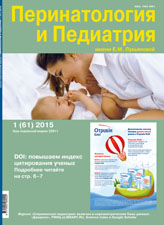Острые вопросы состояния здоровья и развития «поздне недоношенных детей»
DOI:
https://doi.org/10.15574/47363Аннотация
Представлены данные обзора современной литературы касательно состояния здоровья и особенностей развития при долгосрочных наблюдениях
детей, родившихся в срок беременности 34–37 недель, так называемых «поздно недоношенных детей». Большинство исследователей делают акцент
на том, что данная категория детей нуждается в прицельном мониторинге состояния здоровья и развития. Несмотря на большое количество иссле
дований, посвященных данному вопросу, существует необходимость долгосрочных дальнейших исследований. Авторы предусматривают важность
данной информации для семейного врача при оказании медицинской помощи поздно недоношенным детям.
Ключевые слова: поздно недоношенные дети, здоровье, развитие.
Библиографические ссылки
Teune MJ, Bakhuizen S, Bannerman GC et al. 2011. A systematic review of severe morbidity in infants born late preterm. Am J Obstet Gynecol. 205(4): 374. http://dx.doi.org/10.1016/j.ajog.2011.07.015; PMid:21864824
Kapellou O, Counsell SJ, Kennea N et al. 2006. Abnormal cortical development after premature birth shown by altered allometric scaling of brain growth. PLoS Med. 3(8): 265. http://dx.doi.org/10.1371/journal.pmed.0030265; PMid:16866579 PMCid:PMC1523379
Hirvonen M, Ojala R, Korhonen P et al. Cerebral Palsy Among Children Born Moderately and Late Preterm. Pediatrics. 6;134: 1584—1593.
Cheng YW, Kaimal AJ, Bruckner TA et al. 2011. Perinatal morbidity associated with late preterm deliveries compared with deliveries between 37 and 40 weeks of gestation. BJOG. 118(13): 1446—1454. http://dx.doi.org/10.1111/j.1471-0528.2011.03045.x; PMid:21883872 PMCid:PMC340329
Kalia JL, Visintainer P, Brumberg HL. 2009. Comparison of enrollment in interventional therapies between late-preterm and very preterm infants at 12 months' corrected age. Pediatrics. 123(3): 804—809. http://dx.doi.org/10.1542/peds.2008-0928; PMid:19255006
McGowan JE, Alderdice FA, Holmes VA, Johnston L. 2011. Early childhood development of late-preterm infants: a systematic review. Pediatrics. 127(6): 1111—1124. http://dx.doi.org/10.1542/peds.2010-2257
McGowan JE, Alderdice FA, Holmes VA, Johnston L. 2011. Early Childhood Development of Late-Preterm Infants: A Systematic Review [text]. Pediatrics. 6;127: 1111—1124. http://dx.doi.org/10.1542/peds.2010-2257; PMid:21624885
Shapiro-Mendoza CK, Tomashek KM, Kotelchuck M et al. 2008. Effect of late-preterm birth and maternal medical conditions on newborn morbidity risk. Pediatrics. 121(2): 322—326. http://dx.doi.org/10.1542/peds.2006-3629; PMid:18245397
Engle WA, Tomashek KM, Wallman C. 2007. «Late-Preterm» Infants: A Population at Risk. Committee on Fetus and Newborn. Pediatrics. 6;120: 1390—1401. http://dx.doi.org/10.1542/peds.2007-2952; PMid:18055691
Marret S, Ancel P, Marpeau L et al. 2007. EPIPAGE Study Group. Neonatal and 5 year outcomes after birth at 30-34 weeks of gestation. Obstet Gynecol. 110(1): 72—80. http://dx.doi.org/10.1097/01.AOG.0000267498.95402.bd; PMid:17601899
Goyal NK, Fiks AG, Lorch SA. 2011. Association of late-preterm birth with asthma in young children: practice-based study. Pediatrics. 128(4): 830. http://dx.doi.org/10.1542/peds.2011-0809
Pierson CR, Folkerth RD, Haynes RL et al. 2004. Gray matter injury in premature infants with or without periventricular leukomalacia. J Neuropathol Exp Neurol. 62: 5.
De Luca R, Boulvain M, Irion O et al. 2009. Incidence of early neonatal mortality and morbidity after late-preterm and term cesarean delivery. Pediatrics. 123(6): 112—116. http://dx.doi.org/10.1542/peds.2008-2407; PMid:19482739
Petrini JR, Dias T, McCormick MC et al. 2009. Increased risk of adverse neurological development for late preterm infants. J Pediatr. 154(2): 169—176. http://dx.doi.org/10.1016/j.jpeds.2008.08.020; PMid:19081113
Petrini JR, Dias T, McCormick MC et al. 2009. Increased risk of adverse neurological development for late preterm infants. J Pediatr. 154(2): 169—176. http://dx.doi.org/10.1016/j.jpeds.2008.08.020; PMid:19081113
Petrini JR, Dias T, McCormick MC et al. 2009. Increased risk of adverse neurological development for late preterm infants. J Pediatr. 154(2): 169—179. http://dx.doi.org/10.1016/j.jpeds.2008.08.020; PMid:19081113
Santos IS, Matijasevich A, Domingues MR et al. 2009. Late preterm birth is a risk factor for growth faltering in early childhood: a cohort study. BMC Pediatr. 9: 71—78. http://dx.doi.org/10.1186/1471-2431-9-71; PMid:19917121 PMCid:PMC2780991
Late Preterm Infants: Near Term But Still in a Critical Developmental Time Period. Pediatrics. 2013. 4;132: 741—751.
Loftin RW, Habli M, Snyder CC et al. 2010. Late preterm birth. Rev Obstet Gynecol. 3(1): 10—19. PMid:20508778 PMCid:PMC2876317
Abe K, Shapiro-Mendoza CK, Hall LR, Satten GA. 2010. Late preterm birth and risk of developing asthma. J Pediatr. 157(1): 74—78. http://dx.doi.org/10.1016/j.jpeds.2010.01.008; PMid:20338577
Moster D, Terje Lie R, Markestad T. 2008. Long-term medical and social consequences of preterm birth. N Engl J Med. 359(3): 262—273. http://dx.doi.org/10.1056/NEJMoa0706475; PMid:18635431
Leone A, Ersfeld P, Adams M et al. 2012. Neonatal morbidity in singleton late preterm infants compared with full-term infants. Acta Paediatr. 101(1): 6—10. http://dx.doi.org/10.1111/j.1651-2227.2011.02459.x; PMid:21895764
Langenveld J, Ravelli AC, van Kaam AH et al. 2011. Neonatal outcome of pregnancies complicated by hypertensive disorders between 34 and 37 weeks of gestation: a 7 year retrospective analysis of a national registry. Am J Obstet Gynecol. 205(6): 540—547. http://dx.doi.org/10.1016/j.ajog.2011.07.003
Khashu M, Narayanan M, Bhargava S, Osiovich H. 2009. Perinatal outcomes associated with preterm birth at 33 to 36 weeks' gestation: a population-based cohort study. Pediatrics. 123(1): 109—113. http://dx.doi.org/10.1542/peds.2007-3743
Crump C, Winkleby MA, Sundquist J, Sundquist K. 2011. Risk of asthma in young adults who were born preterm: a Swedish national cohort study. Pediatrics. 127(4): 913. http://dx.doi.org/10.1542/peds.2010-2603
Chyi LJ, Lee HC, Hintz SR et al. 2008. School outcomes of late preterm infants: special needs and challenges for infants born at 32 to 36 weeks gestation. J Pediatr. 53(1): 25—31. http://dx.doi.org/10.1016/j.jpeds.2008.01.027; PMid:18571530
Gunville CF, Sontag MK, Stratton KA et al. 2010. Scope and impact of early and late preterm infants admitted to the PICU with respiratory illness. J Pediatr. 157(2): 209—214. http://dx.doi.org/10.1016/j.jpeds.2010.02.006; PMid:20338574 PMCid:PMC2892737
Welliver TP, Garofalo RP, Hosakote Y et al. 2007. Severe human lower respiratory tract illness caused by respiratory syncytial virus and influenza virus is characterized by the absence of pulmonary cytotoxic lymphocyte responses. J Infect Dis. 195(8): 1126—1136. http://dx.doi.org/10.1086/512615; PMid:17357048
Shapiro-Mendoza CK, Lackritz EM. 2012. Epidemiology of late and moderate preterm birth. Semin Fetal Neonatal Med. 17(3): 120—125. http://dx.doi.org/10.1016/j.siny.2012.01.007; PMid:22264582
Colin AA, Wohl ME, Mead J et al. 1989. Transition from dynamically maintained to relaxed end-expiratory volume in human infants. J Appl Physiol. 67(5): 2107—2111.
Vohr B. 2013. Long-term outcomes of moderately preterm, late preterm, and early term infants. Clin Perinatol. 40(4): 739—751. http://dx.doi.org/10.1016/j.clp.2013.07.006; PMid:24182959
WHO. http://www.who.int/mediacentre/factsheets/fs363/en.
Young PC, Korgenski K, Buchi KF. 2013. Early readmission of newborns in a large health care system. Pediatrics. 131(5): 1538. http://dx.doi.org/10.1542/peds.2012-2634; PMid:23569092

